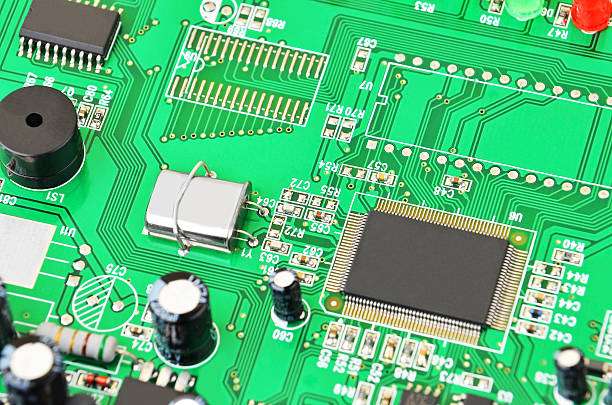
Wearable Tech and Beyond: The Role of Integrated Circuits in Miniaturization
Amidst the swiftly evolving technology landscape, one of the foremost advancements remains the shrinking size of devices. The journey has been transformative, from the bulky mainframes of the past to sleek, powerful gadgets we carry in our pockets today. Wearable technology, in particular, has emerged as a cornerstone of this miniaturization trend, revolutionizing how we interact with and perceive our digital world. At the heart of this transformation lies the integral role of integrated circuits (ICs), the unsung heroes powering our compact devices.
Understanding Integrated Circuits
Integrated circuits, commonly referred to as ICs or microchips, form the fundamental component of nearly all electronic devices utilized in contemporary times.These compact and intricate circuits comprise transistors, resistors, capacitors, and various other electronic components collaborating to execute specific tasks. The innovation lies in the consolidation of these components into a single chip, enabling ic components suppliers with enhanced performance, reduced power consumption, and, crucially, smaller form factors.
The Birth of Wearable Tech
The journey of miniaturization gained significant momentum with the advent of wearable technology. Devices such as smartwatches, fitness trackers, and augmented reality glasses necessitated a transition from conventional, bulky components to streamlined, durable solutions. This is where integrated circuits stepped into the spotlight, offering a solution that aligns with the demands of these innovative devices.
Key Contributions of Integrated Circuits to Wearables:
• Size Reduction: Integrated circuits enable integrating multiple functions onto a single chip, reducing the physical size of components. This downsizing is pivotal in creating wearable devices that seamlessly blend into our daily lives.
• Power Efficiency: Wearables often operate on battery power, and efficiency is paramount. Integrated circuits optimize power consumption, extending battery life without compromising performance. This is a crucial factor in ensuring wearables are practical for daily use.
• Multi-Functionality: With the ability to house various components on a single chip, integrated circuits empower wearables to offer many features. Thanks to these tiny yet powerful circuits, wearables have become versatile companions for everything from health monitoring to communication and navigation.
Beyond Wearables: The Ripple Effect of Miniaturization
While wearables have been a driving force behind miniaturization, the impact of integrated circuits extends far beyond wrist-worn gadgets. The principles of size reduction, increased efficiency, and multi-functionality have permeated various industries, shaping the design and functionality of various devices.
Smartphones and Tablets: The Pocket Revolution
The remarkable evolution of smartphones and tablets is a testament to the triumph of miniaturization in the tech industry. At the core of this transformation are integrated circuits (ICs), which have played a pivotal role in reducing once hefty devices into pocket-sized powerhouses. As consumer demands for sleeker, more portable gadgets surged, manufacturers turned to advanced ICs to meet and exceed these expectations.
Miniaturization Milestones in Mobile Devices:
• Processor Advancements: Integrated circuits, particularly processors, have undergone extraordinary advancements in speed, efficiency, and size. This technological leap by integrated circuit supplier has created thin yet powerful smartphones that effortlessly fit into our hands. The miniaturization of processors has not only enhanced the aesthetics of these devices but also significantly improved their overall performance.
• Battery Technology: The revolution in integrated circuits has extended to battery management in mobile devices, ushering in an era of more extended usage and faster charging. These breakthroughs are pivotal in creating a seamless and uninterrupted user experience, addressing a longstanding challenge in mobile technology. The marriage of miniaturization and battery technology has elevated the efficiency and reliability of smartphones and tablets.
• Sensor Integration: Integrated circuits have facilitated the seamless integration of various sensors into mobile devices. From fingerprint scanners to facial recognition technology, these sensors enhance the security features of smartphones and tablets and open up new frontiers in user interaction and augmented reality applications. This incorporation highlights the versatility and adaptability of integrated circuits, converting mobile devices into versatile tools that surpass conventional limitations.
Medical Devices: Empowering Health in Small Packages
In healthcare, miniaturization has paved the way for innovative medical devices that are portable and capable of delivering precise diagnostics and treatments. Integrated circuits have been instrumental in this paradigm shift, enabling sophisticated yet compact medical solutions to be developed.
Integrated Circuits' Impact on Medical Technology:
• Implantable Devices: Miniaturized integrated circuits have made it possible to create implantable medical devices, such as pacemakers and insulin pumps. These tools offer increased subtlety and improve the well-being of individuals living with chronic health conditions.
• Wearable Health Monitors: Integrated circuits are the backbone of wearable health monitors that track vital signs, detect anomalies, and provide valuable data for healthcare professionals. The small form factor ensures these devices are comfortable to wear, encouraging continuous monitoring.
• Telemedicine Devices: Integrating advanced ICs in telemedicine Colorado devices has facilitated remote patient monitoring and consultations. This has become increasingly important, mainly when healthcare access may be limited.
Internet of Things (IoT): Connecting the World in Miniature
The Internet of Things, which consists of interconnected devices exchanging data, heavily depends on the miniaturization enabled by integrated circuits. The capacity to integrate robust computing capabilities into small-scale dimensions has revolutionized our interaction with our surroundings, spanning from smart home gadgets to industrial sensors.
Integrated Circuits' Contribution to the IoT Ecosystem:
• Sensor Networks: IoT devices often rely on many sensors to collect and transmit data. Integrated circuits enable the integration of these sensors in a space-efficient manner, allowing for the creation of comprehensive sensor networks.
• Edge Computing: Thanks to the miniaturization of processing units, IoT devices can execute intricate computations locally, diminishing the necessity for continuous communication with centralized servers. This not only improves response times but also enhances data privacy and security.
• Energy Efficiency: Many IoT devices operate on battery power or energy harvesting mechanisms. Integrated circuits prioritize power efficiency, enabling these devices to function for prolonged durations without the need for frequent battery replacements.
Challenges and Future Prospects
While integrated circuits have undeniably fueled the miniaturization revolution, some challenges must be addressed. The increasing complexity of circuits, potential heat generation, and the need for sustainable manufacturing practices are among the key considerations. However, ongoing research and development continuously push the boundaries of what is possible.
Future Prospects:
• 3D Integration: Researchers are exploring the three-dimensional integration of circuits, stacking multiple layers of components. This promises to reduce devices' physical footprint further while enhancing overall performance.
• Flexible Electronics: Developing flexible integrated circuits opens up possibilities for bendable and stretchable devices. This is particularly promising for wearables, where conforming to the contours of the human body is essential.
• Quantum Computing: While still in its infancy, the potential of quantum computing holds promise for a new era of computing power. Integrated circuits are integral to developing quantum processors that can revolutionize how we approach complex problem-solving.
Conclusion
As we continue to witness the proliferation of technology in every aspect of our lives, the role of integrated circuits in miniaturization cannot be overstated. From the inception of wearables to the far-reaching impact on smartphones, medical devices, and the Internet of Things, integrated circuits have been the driving force behind more minor, innovative, and efficient devices.
As we look to the future, the relentless pursuit of innovation ensures that the journey of miniaturization is far from over, promising a world where powerful capabilities can be housed in the smallest packages. Integrated circuits, the unsung heroes of our digital age, will continue to shape the technological landscape for generations to come.

Local Business Listing
Get a PagePromote your business to local customers.
device In Technology
best led light companies in india
Added On (2024-02-21 22:42)
role of integrated circuits in miniaturization
Added On (2024-01-29 22:47)
pulse jet baghouse an advanced solution for industrial air purification
Added On (2024-01-22 22:27)
benefits of using webcam for work and life
Added On (2023-06-16 00:24)




